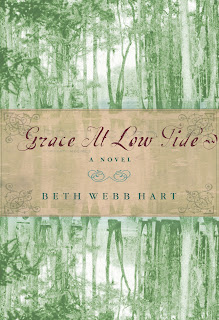A story idea factory. I heard they have these for preachers. How about one for authors?
Of course, that would take the mystery out of it, wouldn’t it? Not to mention the faith. And the element of surprise for the author when the plot takes an unexpected turn, when a character shows up and refuses to leave even when you try to write her out. Essentially, the fun of the process.
“Where do you get your story ideas?” It’s a question I’m asked frequently by readers, and it’s a tricky one to answer. Kind of like trying to hold a fresh caught trout in a wobbly boat long enough to take a photo. (Splash!)
It’s happened differently with each of my novels so I’ll just take a couple and try to explain it:
Grace at Low Tide was my first novel. It was about a blue-blood Charleston family who loses everything in a failed real estate venture and moves to Edisto Island to become the caretakers of a plantation that used to belong in their family. How did I get the idea? Well, I can remember it striking me like lightening one Sunday morning at Trinity Episcopal Church on Edisto just as I stood to sing a hymn toward the end of the service. (I can’t remember the hymn… sorry.) I was headed to New York to graduate school for creative writing, and I knew I had to graduate with a novel in hand if I was ever going to make it as a writer. But, I needed an idea.
I’d spent the summer on Edisto waiting tables and serving as a nanny for a caretaker family on an old plantation. Add to that my parents’ ups and downs in the real estate world, my adoration of fifteen year old female narrators and my love of Edisto and a novel was born. Honestly, I think God gave it to me – the conflict, the story seed, just as I stood up to sing. It was Grace (hence, the title) and as soon as I started school, the story began.
The Wedding Machine came out of a dinner conversation my husband and I had with one of my best friends, Jenny Dickinson. We were comparing our wedding stories only to learn that Jenny – like me- has a whirlwind of a Mama in a small southern town who worked together with her friends to make each of their daughter’s weddings an exceptional event. “It’s like a well-oiled machine!” my husband had proclaimed over his bowl of shrimp creole, still marveling at how my mother and her friends pulled off a 500 plus wedding without a hired wedding planner. “Once it’s set in motion, nothing can stop it.” And then he turned to me and said, “Honey, that would be a great idea for a novel.” And so, The Wedding Machine was born.
I’ll end with this brief quote from the memoir of one of my favorite writers, Lois Lowry. Lowry has one numerous Newberry Medals for her exquisite Young Adult novels, and she summed up so beautifully how her stories come to her – an odd mixture of real life experiences, a tank full of gas in the imagination’s engine and most importantly of all, a ball that simply starts to roll. Here it is:
At Boston’s Logan Airport, in Terminal C, there is a kinetic sculpture: a sculpture that moves. Even though Terminal C has a food court, a seafood restaurant, a bookstore, and even a beauty parlor, it is the always-in-motion, pinging, dinging sculpture that commands the attention of everyone: travelers, toddlers, and trash collectors.
A ball sets off from the top (ding!) and makes its way through tubes, across intersections, down lifts and stairs and slides; along the way it bumps into another ball (chime!) and sets that one rolling around corners and along passages, and eventually it, too, collides (ping!) with another and sends it on its way. A ball sets off from the top (ding!) and makes its way through tubes, across intersections, down lifts and stairs and slides; along the way it bumps into another ball (chime!) and sets that one rolling around corners and along passages, and eventually it, too, collides (ping!) with another and sends it on its way.A ball sets off from the top (ding!) and makes its way through tubes, across intersections, down lifts and stairs and slides; along the way it bumps into another ball (chime!) and sets that one rolling along corners and along passages, and eventually, it too collides (ping!) with another and sends it on its way.
Everything that happens causes something else to happen. Just like life. A dog bites a mailman and the mailman drops his bag and scatters some letters on a lawn. One disappears under a bush and is lost. Maybe it was a love letter. Maybe the woman who failed to receive the letter decided the heck with it and went to law school – or to Australia – or to a therapist; and because of that, the man who sent the letter (but received no reply) decided to buy a dog to keep him company; and then he took the dog to obedience classes, where it met a dog who had bitten a mailman, and…
Well, you get the idea. Stories don’t just appear out of nowhere. They need a ball that starts to roll.
– Lois Lowry from her memoir, Looking Back
For more info on Beth Webb Hart’s novels click here




